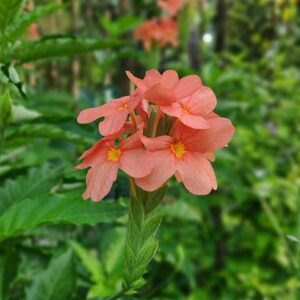Introduction
The Lucky Bamboo plant, scientifically known as Dracaena sanderiana, is a popular indoor plant that is believed to bring good luck and prosperity in Chinese culture. However, it is not actually a bamboo plant, but rather a member of the Dracaena family.
The Lucky Bamboo plant is typically grown in a container of water and pebbles, with the stems of the plant standing upright. It can also be grown in soil, although it is less commonly done. When grown in water, the plant tends to have shorter and thinner stems, while growing in soil can result in thicker and taller stems. It is a slow-growing plant that can reach a height of up to 3 feet under ideal conditions.
To create an exquisite indoor garden, you may want to pair your Lucky Bamboo plant with a Chinese Ixora plant or a Schefflera plant.
The Chinese Ixora plant boasts striking red flowers that make for a beautiful contrast against the Lucky Bamboo’s green stems. The Schefflera plant, with its large and glossy leaves, will offer a bold and luxurious background for the slender stems of the Lucky Bamboo.
Click on the headings to read more!
Benefits
Here are some of the benefits associated with growing Lucky Bamboo:
Aesthetic Appeal
- The Lucky Bamboo plant has an attractive appearance that can add a touch of greenery to any room.
- It comes in a variety of shapes and sizes, making it a versatile decorative plant that can suit different preferences and spaces.
- Its unique appearance, with slender stalks and lush leaves, is sure to catch the eye and enhance the visual appeal of your indoor space.
Low Maintenance
- The Lucky Bamboo plant is easy to care for and requires minimal maintenance, making it an ideal plant for busy people or those new to plant care.
- It can thrive in a variety of growing conditions, including low light and indoor environments.
- With just a little bit of water and occasional fertilization, it can stay healthy and vibrant for years.
Air Purification
- According to a study by NASA, the Lucky Bamboo plant can help to purify the air by removing toxins such as formaldehyde, benzene, and carbon monoxide.
- This makes it a great plant to have in your home or office to improve indoor air quality and promote a healthier environment.
- With its air-purifying properties, it can help to reduce the risk of respiratory problems and other health issues caused by indoor air pollution.
Feng Shui
- The Lucky Bamboo plant is often associated with the principles of feng shui, which is the Chinese art of placement and harmonizing energy.
- In feng shui, the Lucky Bamboo plant is believed to bring luck, prosperity, and positive energy into the home or office.
- By placing the plant in certain areas of your space, such as the wealth or career corner, you can enhance its feng shui benefits and attract more positive energy and good fortune into your life.
Plant care
Lucky Bamboo plant is easy to care for and maintain. Here are some tips:
Soil
- For planting in soil, choose a well-draining potting mix that is rich in organic matter.
- Avoid heavy soils that can become waterlogged, as this can cause root rot.
Pot Selection
- Choose a pot that is slightly larger than the root ball of your lucky bamboo plant.
- Make sure the pot has drainage holes to allow excess water to drain away from the roots.
Watering
- Water your Lucky Bamboo plant regularly, making sure that the soil stays moist but not waterlogged.
- If growing in water, change the water every few weeks and keep the level consistent.
Light
- Place your plant in bright, indirect sunlight or low light conditions.
- Avoid placing it in direct sunlight, which may scorch the leaves.
Temperature and Humidity
- Maintain a temperature range between 65 and 90°F (18-32°C).
- Keep high humidity levels around your plant by misting the leaves regularly or using a tray of water or a humidifier.
Fertilization
- Lucky Bamboo plants do not require fertilizer but can benefit from occasional feeding.
- If you choose to fertilize, use a balanced liquid fertilizer at half-strength once a month during the growing season.
- Avoid using tap water to dilute the fertilizer, as the chemicals in tap water can harm the plant.
- Instead, use distilled or filtered water to dilute the fertilizer before adding it to the plant’s water.
Pruning
- Prune your plant as needed to maintain its shape and size.
- Cut stems just above a node to encourage new growth.
Other Care Tips
- Avoid placing your bamboo plant near air conditioning or heating vents.
- Treat any pest infestations with an insecticidal soap or neem oil solution.
- Use clean, sharp pruning shears when trimming your plan.
Propagation
Here are some tips on propagating your bamboo plant:
-
Stem Cuttings
- Take a stem cutting from your existing bamboo plant using clean, sharp shears.
- Cut the stem just below a node (the point where a leaf grows) to encourage new root growth.
- Place the cutting in a vase or container of clean water, making sure that the node is submerged.
- Change the water after some days to keep it fresh and oxygenated.
- Wait for roots to form on the cutting before planting it in soil or continuing to grow it in water.
-
Root Division
- If your bamboo plant has multiple stems, you can divide it into smaller plants by separating the root ball.
- Gently remove the plant from its pot and carefully separate the stems and roots.
- Replant each stem in a new pot with fresh potting mix and water thoroughly.



